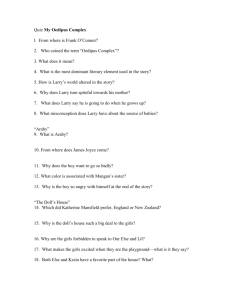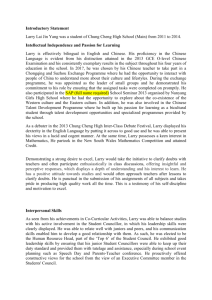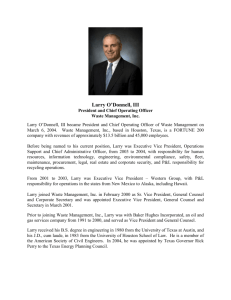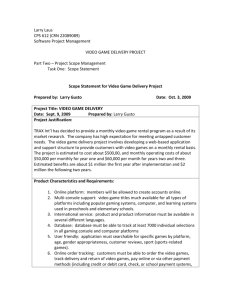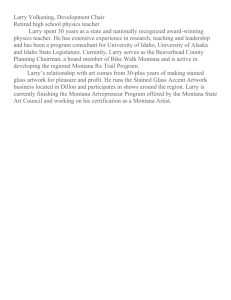October 7, 1996. Larry.
advertisement
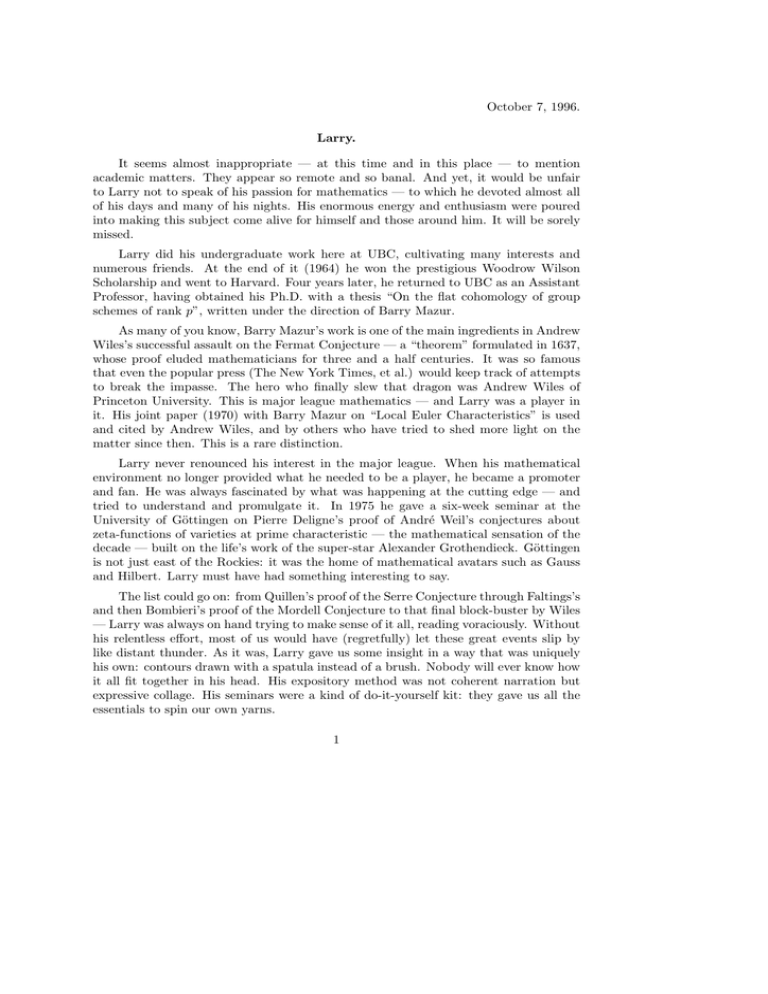
October 7, 1996. Larry. It seems almost inappropriate — at this time and in this place — to mention academic matters. They appear so remote and so banal. And yet, it would be unfair to Larry not to speak of his passion for mathematics — to which he devoted almost all of his days and many of his nights. His enormous energy and enthusiasm were poured into making this subject come alive for himself and those around him. It will be sorely missed. Larry did his undergraduate work here at UBC, cultivating many interests and numerous friends. At the end of it (1964) he won the prestigious Woodrow Wilson Scholarship and went to Harvard. Four years later, he returned to UBC as an Assistant Professor, having obtained his Ph.D. with a thesis “On the flat cohomology of group schemes of rank p”, written under the direction of Barry Mazur. As many of you know, Barry Mazur’s work is one of the main ingredients in Andrew Wiles’s successful assault on the Fermat Conjecture — a “theorem” formulated in 1637, whose proof eluded mathematicians for three and a half centuries. It was so famous that even the popular press (The New York Times, et al.) would keep track of attempts to break the impasse. The hero who finally slew that dragon was Andrew Wiles of Princeton University. This is major league mathematics — and Larry was a player in it. His joint paper (1970) with Barry Mazur on “Local Euler Characteristics” is used and cited by Andrew Wiles, and by others who have tried to shed more light on the matter since then. This is a rare distinction. Larry never renounced his interest in the major league. When his mathematical environment no longer provided what he needed to be a player, he became a promoter and fan. He was always fascinated by what was happening at the cutting edge — and tried to understand and promulgate it. In 1975 he gave a six-week seminar at the University of Göttingen on Pierre Deligne’s proof of André Weil’s conjectures about zeta-functions of varieties at prime characteristic — the mathematical sensation of the decade — built on the life’s work of the super-star Alexander Grothendieck. Göttingen is not just east of the Rockies: it was the home of mathematical avatars such as Gauss and Hilbert. Larry must have had something interesting to say. The list could go on: from Quillen’s proof of the Serre Conjecture through Faltings’s and then Bombieri’s proof of the Mordell Conjecture to that final block-buster by Wiles — Larry was always on hand trying to make sense of it all, reading voraciously. Without his relentless effort, most of us would have (regretfully) let these great events slip by like distant thunder. As it was, Larry gave us some insight in a way that was uniquely his own: contours drawn with a spatula instead of a brush. Nobody will ever know how it all fit together in his head. His expository method was not coherent narration but expressive collage. His seminars were a kind of do-it-yourself kit: they gave us all the essentials to spin our own yarns. 1 Larry was a living counter-example to many contemporary academic clichés. In spite of his passionate engagement in mathematics, his list of publications was remarkably short. In spite of his poor elocution and terrible handwriting, he was one of our best-loved and most successful teachers. And although he was an extremely private man — when you spoke with him, you felt the warmth of a wide open mind. His classes must have had the same spontaneous, interactive character as his seminars. This style requires a lot of preparation and resourcefulness from the teacher, but does turn the student into an active participant — the only state in which he or she can actually learn something. Students at all levels greatly appreciated the sense of mission and the sense of humour of this energetic but self-effacing guide. In 1972, he was among the finalists for the university’s Master Teacher Award; in 1988, he won the Science Undergraduate Teaching Award. His favourite mode was teaching small groups or single individuals. He hardly ever socialized with us in the coffee room — too busy, usually rushing off to meet a student. He attracted many of our brightest undergraduates and, by what he called “research oriented teaching” prepared them for careers at famous universities. Of course, he also supervised graduate students — usually in difficult topics. Under his guidance at least 5 M.Sc. and 3 Ph.D. degrees (one of them shared with Jim Carrell) were obtained. He gave many reading courses — an ungrateful task without remuneration — and spent his summers directing undergraduates in various worthy projects. Every sizable community depends on certain selfless individuals who work behind the scenes to keep it together and afloat. Larry was one of these for our department. By his own count he spent about 3000 hours between 1981 and 1987 to bring the TEX program to UBC’s main-frame computer. Now that it has become the world standard for mathematical typesetting — which we all have on our own PC’s — that extraordinary effort is just a historical anecdote. And so it goes: much of what Larry did for us will forever remain in the shadows. Larry’s greatest gift to us was his unfailing willingness to serve and to listen. When speaking to him, you always felt that you had his full attention. It was like being alone with him on an island where nothing else mattered. On this island there was no fear of embarrassment or judgment — just the effort reflected in his quizzical eyes of his mind trying to understand the movements of yours. This space without fear was Larry’s most precious gift to those who knew him. To anyone looking for help, advice, or just a ready ear, Larry was an open door. This door is now closed. Lawrence Gordon Roberts died unexpectedly in the night of his 54-th birthday, Sepember 28, 1996. This text is part of the eulogy spoken at his funeral. 2
